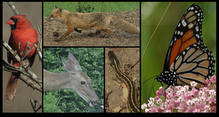Red-Tailed Fox: Turning on a Dime to Hunt Squirrels
Here is the second additional post showing a ‘run’ of the fox at the squirrels.


Wildlife observations from a suburban backyard adjacent to the Colvin Run Mill Park in Vienna, Virginia. Click on photos to enlarge.
Here is the second additional post showing a ‘run’ of the fox at the squirrels.


Posted by
Gil Miller
at
10:50 PM
![]()
Labels: Eastern Gray Squirrel, Red-tailed Fox

This work is licensed under a Creative Commons Attribution-NonCommercial 3.0 License.

Question....I live in Annandale, Va. My backyard is full of squirrels, and I swear, I have seen a fox. Can this be possible where 495 is a 1/2 mile away from my apartment? There is a little sanctuary of forest growth tucked away from the traffic. I have a bird feeder, and I see cardinals, blue jays, and have even seen a hawk swoop down to the trees and grasp a squirrel with its claws and fly away. Is this normal for all of this habitat to be in such a small area?? And, would a fox be living here?
ReplyDeleteJ - Annandale in Fairfax County, Va., is amazingly full of a variety of wildlife. Your backyard has indeed become a small ecosystem. The bird feeder provides food for the smaller birds (cardinals, blue jays, and I'll guess chickadees and titmice) which provide food for the hawks (most likely Cooper's or possibly Red-Shouldered). The dropped seed from the bird feeder attracts squirrels (and possibly chipmunks) which provides food for the foxes. The foxes typically are most active at night, but as you can see from the Colvin Run Habitat blog are sometimes active during the daylight.
ReplyDeleteCongrats on your very own habitat. Add some suet cake feeders and the woodpeckers will come. Add some hummingbird feeders and the hummers will come. Count your blessings in Fairfax County if you do not have deer, which eat any flower and most shrubs in the Colvin Run Habitat.